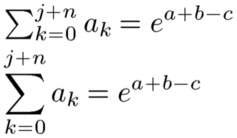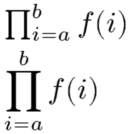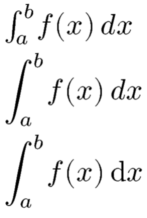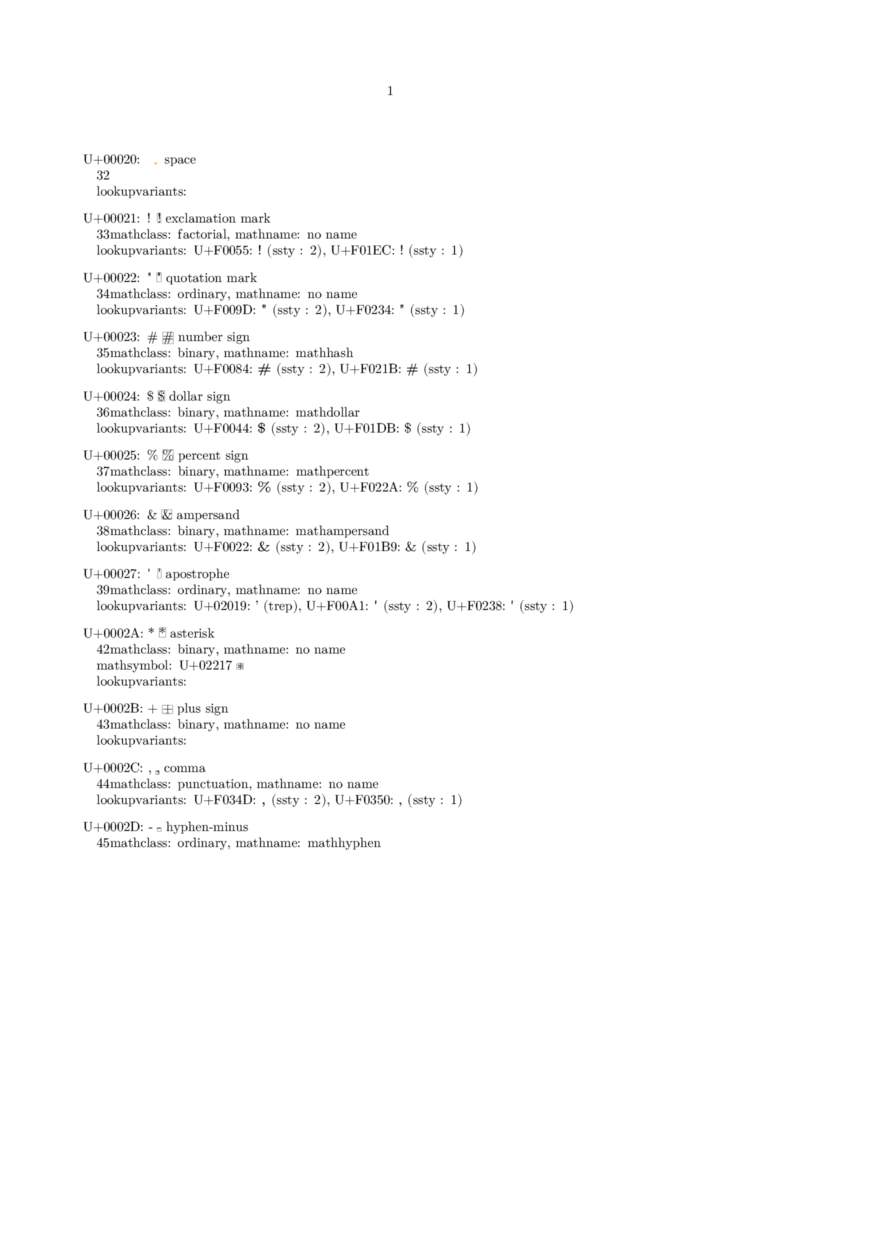Math/basic
Contents
Binary Operators Relations
Basic binary symbols can be produced by typing the correspoding keyboard character. These include
+ - = < >
A general expressions can be input in the natural manner. For example $x+y$ gives  . Notice that TeX took care of the spacing around
. Notice that TeX took care of the spacing around +. Mathematicians use a lot of symbols that are not avialable on the keyboard. TeX (and ConTeXt) provide macros to input them. For example $x \times y$ gives  . The following is a parial list of frequently used binary operators and relations.
. The following is a parial list of frequently used binary operators and relations.
| Commonly Used Binary Operators | Commonly used relation symbols | Set Relations | |||
|---|---|---|---|---|---|
| \pm | 
|
\leq | 
|
\subset | 
|
| \mp | 
|
\ll | 
|
\subseteq | 
|
| \times | 
|
\geq | 
|
\supset | 
|
| \div | 
|
\gg | 
|
\supseteq | 
|
| \ast | 
|
\equiv | 
|
\cap | 
|
| \star | 
|
\sim | 
|
\cup | 
|
| \bullet | 
|
\simeq | 
|
\in |

|
| \circ | 
|
\approx | 
| ||
| \cdot | 
|
\neq | 
| ||
Sums, products, integrals
Sums with \sum
\setupbodyfont[14pt] \framed[frame=off,align=normal]{% \m{\sum_{k = 0}^{j + n} a_k = e^{a + b - c}} \blank[small] \dm{\sum_{k = 0}^{j + n} a_k = e^{a + b - c}}}

Products with \prod
\setupbodyfont[14pt] \framed[frame=off,align=normal]{% \m{\prod_{i=a}^{b} f(i)} \blank[small] \dm{\prod_{i=a}^{b} f(i)}}

Integrals with \int
\setupbodyfont[14pt] \framed[frame=off,align=normal]{% \m{\int_a^b f(x) \dd x } \blank[small] \dm{\int_a^b f(x) \dd x } \blank[small] \setupmathematics[differentiald=upright] \dm{\int_a^b f(x) \dd x } \blank[small] }

Greek Letters
To type the greek character α you can say $\alpha$ which gives  . If you have a utf enabled keyboard, you can also type the α directly and ConTeXt will correctly interpret it. For example,
. If you have a utf enabled keyboard, you can also type the α directly and ConTeXt will correctly interpret it. For example,
\enableregime[utf] Here is some Greek math $α^2 + β^2 = γ^2$
Here is a complete list of greek letters
| lowercase greek letters | variation | uppercase greek letters | |||
|---|---|---|---|---|---|
| \alpha | 
| ||||
| \beta | 
| ||||
| \gamma | 
|
\Gamma | 
| ||
| \delta | 
|
\Delta | 
| ||
| \epsilon | 
|
\varepsilon | 
| ||
| \zeta | 
| ||||
| \eta | 
| ||||
| \theta | 
|
\vartheta | 
|
\Theta | 
|
| \iota | 
| ||||
| \kappa | 
| ||||
| \lambda | 
|
\Lambda | 
| ||
| \mu | 
| ||||
| \nu | 
| ||||
| \xi | 
|
\Xi | 
| ||
| \omicron | 
| ||||
| \pi | 
|
\varpi | 
|
\Pi | 
|
| \rho | 
|
\varrho | 
| ||
| \sigma | 
|
\varsigma | 
|
\Sigma | 
|
| \tau | 
| ||||
| \upsilon | 
|
\Upsilon | 
| ||
| \phi | 
|
\Phi | 
| ||
| \chi | 
| ||||
| \psi | 
|
\Psi | 
| ||
| \omega | 
|
\Omega | 
| ||
Subscript and superscript
TeX uses ^ and _ to denote superscipts and subscipts. It is perhaps easiest to explain this by means of some examples.  is written as
is written as $x_{10}^{15}$ or $x^{15}_{10}$. The order in which _ and ^ are given does not matter. One can also type complicated expressions like  as
as $a_{b_{c_{d_{e}}}}$.
To align superscripts and subscripts one after the other (not above/below each other), add empty braces {} after each of them as $T^a{}_b{}^c{}$ to obtain  . This effectively adds each index as superscript/subscript of the empty braces rather than the main character, thus aligning them separately and avoiding double superscript errors.
. This effectively adds each index as superscript/subscript of the empty braces rather than the main character, thus aligning them separately and avoiding double superscript errors.
List of All Math macros
With \usemodule[fnt-25], \showmathfontcharacters produces a lengthy annotated catalogue.
Here is the first page:

In ConTeXt MkII, you can see the list of all math macros by \showmathcharacters.
Spacing
TeX handles math spacing by breaking a formula into parts, and assigning each of those parts a role such as 'Ord' (a variable or number) or 'Rel' (equality, larger than, et cetera). For each combination of roles, it then looks up the spacing appropriate between them in a table. These are the roles:
| Ord | e.g. 4 or a or x2 |
| Op | Unary operators such as sin or ln. |
| Bin | Binary operators such as '+' |
| Rel | Relationships such as '=' or '>' or '\implies' |
| Open | open brackets of any kind |
| Close | closing brackets of any kind |
| Punct | Punctuation: digit separators like '.' or ','. |
| Inner | Fractions are inner. What else is inner? |
To set up e.g. the spacing between ordinal items, do as follows (since dec 2012):
\startsetups math:morespacing
\ordordspacing\textstyle 1mu plus .5mu minus .25mu\relax
\stopsetups
\setupmathematics [setups=math:morespacing]